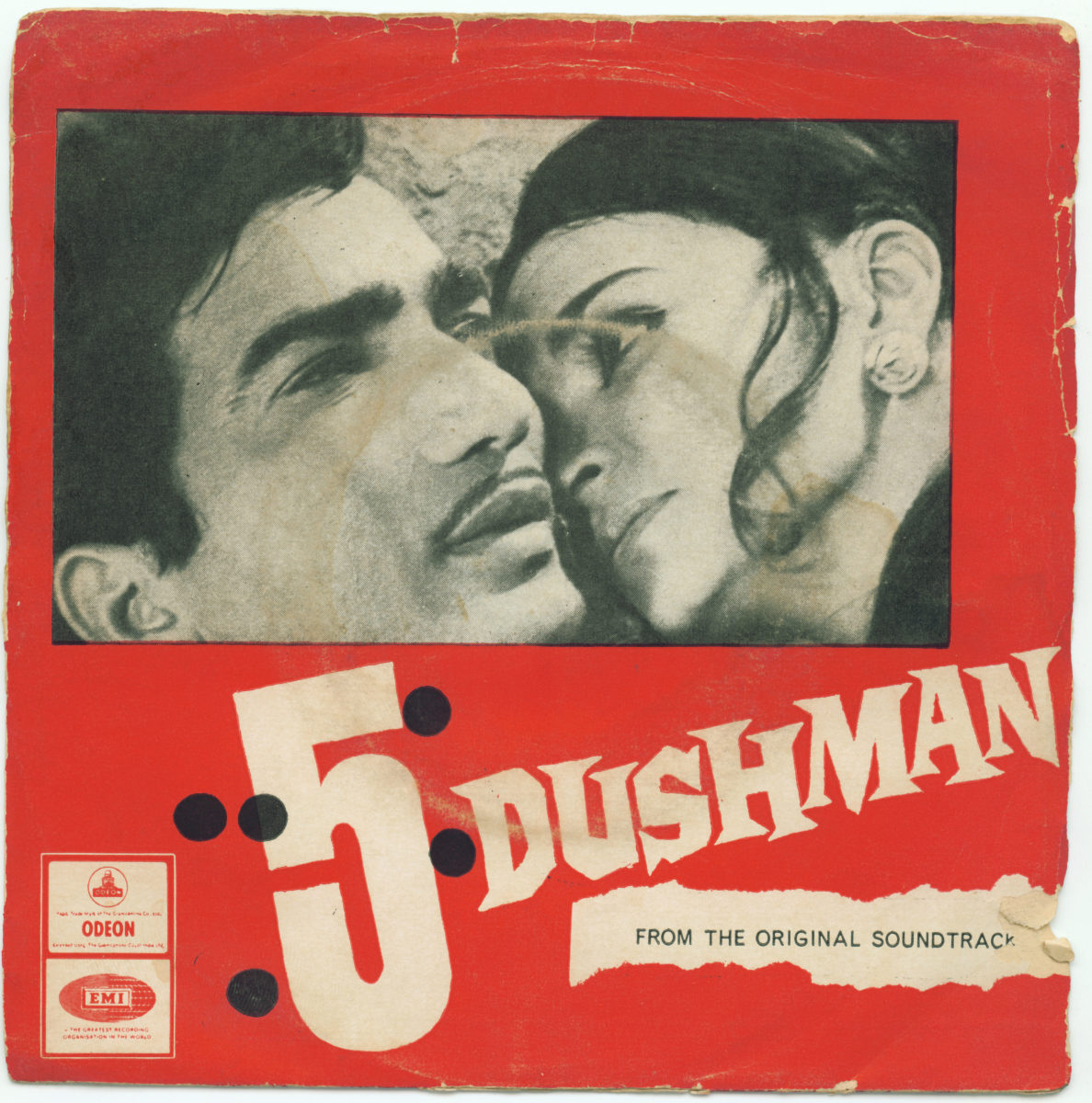Jeena To Hai …

Film: Paanch Dushman (1973) / Daulat ke Dushman (1982)
Producer: M. G. Productions
Director: Bimal Rawal
Lyrics: Majrooh Sultanpuri
Singers: Kishore Kumar
–
This lament from Paanch Dushman found new listeners thanks to featuring (with the original film name), along with other rarities, on the splendid 2-CD compilation Tumse Milke from HMV (the first of hopefully many more collaborations between this music publishing behemoth and the cleansing efforts of Pancham Studios). Its previous CD avatar (CDF 120419) was one of several attempts by HMV at squeezing several less-lauded movie soundtracks onto CDs. There it shared space with Balika Badhu and Doosri Sita under its revised moniker Daulat ke Dushman.
The arrangements on this song are quite sparse; this means that the bulk of its impact relies on the lyrics (and Majrooh achieves much with simple words conveying the futility of life) and the melody.
The musical prologue of the song begins by introducing the underlying riff of the first part: a reverse slide from B down to F# on the sixth string of the bass guitar, two beats on the tabalaa, and a guitar strumming Em. Short fragments from violins and cello are Overlaid on this riff, before Kishore begins the lament on life. While there’s the acoustic guitar providing a background of chords, the flute and guitar/mandolin provide melodic fills between lines and if you listen carefully you can hear the simple backing provided by the string section. The bass guitar has a two-note pattern between counts 2 and 3 of each bar involving the 5th and the tonic. The reso-reso and gourds represent, perhaps, the only prominent percussive element in the song. You can hear the leading taps on a conga, but they’re sparsely laid out.
The muKa.Daa is set in a minor key (Em), although RDB takes a few liberties that I’ll get to in a moment.
Surprise, surprise! There’s no interlude connecting the muKa.Daa to the first a.ntaraa. This is a relatively infrequent device that I’ve seen employed in at least one more RDB song, yet I just can’t seem to remember it. And that’s not just the only thing that’s wrong. We enter the a.ntaraa in a major key (E). The komal ga.ndhaar has been replaced by the shuddh ga.ndhaar. The arrangements remain similar, though: the flute, the guitar/mandolin, the guitar strums; with the string section rushing in near the end and complementing the singing over the turnaround back to the muKa.Daa.
There’s an interlude before the second a.ntaraa, but even that offers nothing complicated. A flute merely repeats the melody of the muKa.Daa with a few variations, and the guitar and bass doing their bit. The interlude segues into the second a.ntaraa with a three-note return (B-A-Ab) on the mandolin (more about this later on).
The song ends with an acoustic guitar repeating the initial part of the muKa.Daa’s melody and then the last thing you hear is a light strum of Em9.
And now some more about the liberties that RDB took. The omission of the third allows the bass pattern to remain consistent throughout the song despite the shifts between a major and minor key. And in the muKa.Daa, the use of the F betrays an overlap of the prevailing E natural minor with E Phrygian. There’s also the use of both sevenths, which would suggest the use of the harmonic minor scale.
A friend had once noted that one of the cool things about the songs of RDB (and occasionally for Jatin-Lalit, whose music contains numerous RDB-esque elements) was that he would repeat melodic fragments and arrangements, but he always managed to make the final product sound different enough so that the repetition was never noticeable unless you paid close attention and listened to the songs a few more times. And then you suddenly started finding yourself singing or humming a portion of another song; which was when the resemblance hit you. This song did that for me. Portions of it echo tum bin jaa_uu.N kahaa.N from PYAR KA MAUSAM. There are similar elements in the arrangements; there’s the connecting riff from the second musical interlude to the second a.ntaraa; and both employ the switch from a minor key to a major key when moving from the muKa.Daa to the a.ntaraa.
A few notes on the two versions that exist on CD are in order. The first version available on the Balika Badhu/ Daulat ke Dushman /Doosri Sita combo is a tad shorter and a lot murkier. What manages to surface is the singer’s voice and everything else takes a backseat in a collective wall of sound in the background. The opening and closing musical fragments are also truncated: the bass lead-in is barely heard in the opening fragment, and the closing fragment breaks off shortly after the guitar coda begins. The remastered version is much brighter and clearer and also contains the opening and closing fragments in their entirety. Another interesting difference is the key of the song: the newer version is in the key of Em in standard tuning; the older version seems to have been recorded in the same key but something probably happened during mastering to knock it a bit lower — and the actual root falls between Eb and E. This is evident in other works like the theme from Sholay and tum jo mile to from Drohi.
George Thomas
Panchammagic.Org

